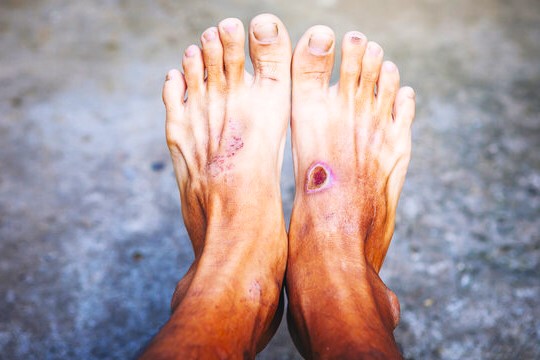Best Diabetic Foot Ulcer Treatment in Andheri

How Do Diabetic Foot Ulcers Develop?
People with diabetes often develop damage to their peripheral nerves (neuropathy). Sensory neuropathy leads to decreased sensation of pain and pressure, which may cause people with diabetes not to feel a sharp object in their shoe that can puncture the skin and cause a foot ulcer. Foot deformities and dry skin, which often occur with diabetic neuropathy, can lead to formation of a callus on the foot. Repetitive stress from walking or minor cuts and scrapes on the foot can cause a callus to develop into an ulcer. Therefore get in touch with us because Dr. Kunal Arora provides Best Diabetic Foot Ulcer Treatment in Andheri.
About 50% of people with a diabetic foot ulcer have peripheral artery disease, a condition that reduces blood flow to the legs. Individuals with diabetic foot ulcers and peripheral artery disease are at increased risk of developing infected ulcers and undergoing foot amputation.
How Are Foot Ulcers in Diabetes Treated?
Treatment for diabetic foot ulcers should include wound care, appropriate wound dressings, and surgical excision of any dead or infected tissue. Antibiotics are required for the treatment of diabetic foot ulcer patients that are infected. By relieving pressure on the ulcer, a prefabricated boot or knee-high cast can aid in the healing process. When patients receive care from a multidisciplinary team, which usually consists of a podiatrist, an infectious disease specialist, and a vascular surgeon, the risk of amputation is reduced.
Leg bypass surgery can be used to restore blood flow to the foot in patients with diabetic foot ulcers and peripheral artery disease, thereby lowering the risk of amputation. Patients who suffer from peripheral artery disease and diabetic foot ulcers may also benefit from minimally invasive vascular surgical procedures, or endovascular therapy. Patients with diabetic foot ulcers and infected bone may need to have part or all of their foot amputated. So book your appointment now with Dr. Kunal Arora because he provides Best Diabetic Foot Ulcer Treatment in Andheri.
Symptoms of Diabetes-Related Foot Issues
Preventing Complications
a) Infection Prevention:
To stop infections, aggressive infection control is required. Because diabetic foot ulcers have high rates of morbidity and mortality, it is advised to treat any infection symptoms with oral and topical antibiotics. Usually, antimicrobial agent-impregnated wound dressings are utilized. In fact, simple gauze could harm the skin. Dressings made of alginate and foam have a high absorbency for moderate to heavy exudate. Collagen and silver hydrogels or dressings work best for diabetic foot ulcers with dying tissue. The most crucial thing is to balance the amount of wound drainage with the wound dressing's capacity to absorb. We provide Best Diabetic Foot Ulcer Treatment in Andheri.
b) Pressure Offloading:
Healing of the diabetic foot ulcer is impeded by pressure. For this reason, a device that more evenly distributes pressure throughout the lower leg may be a crucial component of the treatment plan. Either a removable offloading device or a non-removable total contact cast can be used for this. Regretfully, research indicates that a considerable number of patients who wear detachable devices only wear them for thirty percent of the day, which can have a substantial impact on treatment outcomes.
Risks Of Diabetic Foot Ulcers Treatment
There are a number of inherent risks associated with treating diabetic foot ulcers, which must be carefully managed. First of all, because diabetic patients have weakened immune systems, infection is still a major risk factor. If left untreated, it can result in sepsis, cellulitis, or osteomyelitis (a bone infection). Delay in wound healing is another risk, which is frequently made worse by poor circulation and compromised tissue repair mechanisms linked to diabetes. Furthermore, allergic reactions or unfavorable side effects may result from using specific antibiotics and wound care products. Surgical procedures, including debridement or, in extreme circumstances, amputation, entail a risk of bleeding, complications from anesthesia, and infection following the procedure. Visit to our clinic now and consult with Dr. Kunal Arora who provides the Best Diabetic Foot Ulcer Treatment in Andheri.
Additionally, if preventive measures like good foot care and glycemic control are not strictly maintained post-treatment, there's a chance of developing new ulcers or aggravating existing ones. To reduce these risks and improve outcomes for patients with diabetic foot ulcers, a multidisciplinary approach involving vascular surgeons, podiatrists, infectious disease specialists, and diabetic specialists is essential.
Conclusion
Dr. Kunal Arora provides the Best Diabetic Foot Ulcer Treatment in Andheri. Also A comprehensive and multidisciplinary approach is necessary to manage diabetic foot ulcers in order to reduce risks and achieve positive results. Early detection, careful wound care, infection control, and addressing underlying factors such as poor glycemic control and vascular issues are all necessary for effective treatment. While debridement, offloading, and, in more extreme situations, surgical interventions may be required, these treatments carry inherent risks as well, such as the possibility of infection, slowed healing, and procedural complications. Thus, careful observation by medical specialists in the field of diabetic care is necessary to customize interventions, promote healing, and stop further complications and recurrence. Furthermore, educating patients about diabetes management and foot care is essential for long-term success and lessening the incidence of diabetic foot ulcers.
